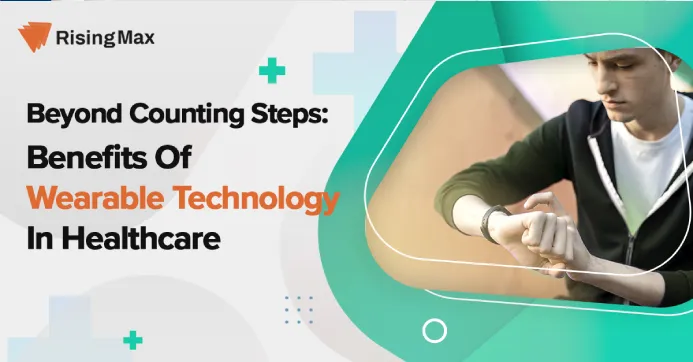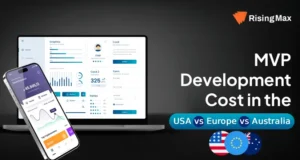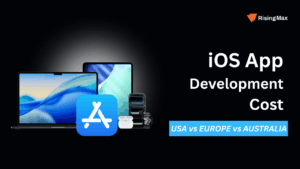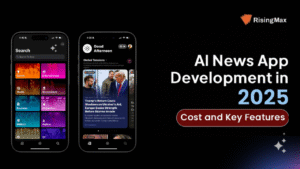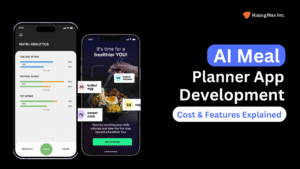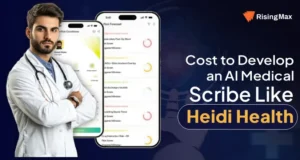As we look forward to the coming years, considering advances made in the healthcare industry over the decade is crucial. Wearable gadgets have taken an important place in recent times along with widespread acceptance in the healthcare business. The varying benefits of wearable technology in healthcare have the potential to provide proven solutions to healthcare issues.

Watches, trackers, and monitors are all examples of wearable healthcare technologies receiving a keen focus, especially during pandemics. Many new wearables are also projected to come into the market, fueled by technological advancements.
Wearable technology is gradually improving our daily lives, recording key bodily parameters such as physical activities, sleep, blood pressure, and blood oxygen levels, among others. These gadgets can track practically all of the user’s daily activities, which aids in the maintenance of health, well-being, and fitness. As wearable technology has a bright future, healthcare software development companies have new chances to make audiences better engage with the digital environment. In this post, we’ll look at some of the most popular wearable devices as well as the health benefits they provide.
What Are Wearable Technologies and How Do They Work?
A wearable is a category of electronic devices that collect and transmit data about the wearer and are often worn as accessories. Wearables have a wide range of applications. For example, consumers can use them to measure critical data throughout the day, monitor their surroundings’ air quality, or as part of a clinical evaluation.
These wearable devices use a variety of technologies, but the majority of them use Bluetooth for connectivity. You can assume the example of smartwatches that use built-in sensors to detect movement and biometrics to collect data. Sensors can use Bluetooth signals, Wi-Fi connectivity, or mobile 4G LTE technology to exchange the data they collect with smartphone apps seamlessly.
The wearable gadgets on the market analyze a wide range of physiological data over time, including heart and respiration rate, blood pressure, temperature, and sleep activity. The information gathered can help healthcare practitioners in disease diagnosis and therapy.
Why Is Wearable Technology Important In Healthcare?
Both doctors and patients use healthcare apps, and it’s clear that the industry is moving toward mobile. Wearable technology has become more popular as a result of this. Wearable technologies in healthcare can help patients receive better care. Wearable monitoring systems can provide the healthcare business with several benefits. Some wearables are beneficial for the maintenance of health conditions, the prevention of sickness, and the recovery of patients.
It’s all about tracking when it comes to wearable healthcare technologies. They keep track of the patient by allowing doctors to see the end-to-end progress. Wearable monitoring gadgets are now being used to achieve fitness goals as well. Many people love utilizing weight-loss wearable technology like step trackers, mini trampolines for exercise or fitness apps that provide exercise and nutrition advice.
Wearable technology has a more significant impact on the healthcare industry than it does on the rest of the economy. This is because every important technical innovation has benefited healthcare practitioners throughout history. The influence of wearable technology is helping doctors, nurses, and patients stay connected.
Also Read: Select the Right IT Technology Consulting Partners for Your Startup?
Wearable Technology in Healthcare Includes Several Devices Like
Fitness Trackers: Fitness trackers are less expensive and focus on usefulness rather than appearances, but the latest models include smartphone functions such as notifications and alarms. Smartwatches used to be limited to telling time and counting steps, but they’ve grown into a sleek combination of smartphone technology and a health monitor. Smartwatches may track physical activity, heart rate and even guide you through a brief meditation.
Smart Bracelets: The Smart Band, like smartwatches, is designed to wear on the wrist. Among the younger generation, the Smart Band is quite popular. It gives the user real-time vital statistics such as physical activity, heart rate, calorie consumption, sleep length, etc. In addition, these Smart Bands can integrate with smartphone apps, allowing the user to track their progress daily.
Biosensors: Wearable biosensors that may be attached to various body areas to collect data. A Health patch is a small, wireless, disposable patch with adhesive qualities that makes it simple to use. They can measure and gather biometric parameters such as skin temperature, stress, breathing rate, sleep length, step count, sleep quality, posture, and many others, depending on the type and size.
Movement Sensors: A motion sensor is an electrical device that detects and records movement. Sensors assess factors that affect a patient’s state, such as oxygen levels or room temperature, whereas medical sensors measure vital signs.
Posture Monitors: These devices help you improve your sitting posture and habits. It monitors your posture while you work or you have been sitting for too long.
Smart Glasses: They allow surgeons to get real-time information about a patient if issues arise, and they can also help them see better during particular sections of the process.
Align the current state of IT with your business strategy by hiring the most trustworthy Healthcare Development Company
What are the Advantages of Wearable Technology in Healthcare?
Patients benefit from wearable technology even more than healthcare providers. Overall, wearable technologies are letting people control their health by decentralizing healthcare away from physicians’ offices and hospitals.
To provide solutions to modern patients and healthcare providers, healthcare software development must keep up with the latest advances in wearable technology. As healthcare becomes more digitized and decentralized, we’ll look at the latest wearable healthcare technologies that will help produce bespoke software.
For healthcare professionals, the real benefit of wearable devices is convenience. They allow them to keep track of a patient’s data and health issues. Here are a few advantages of wearable technology in healthcare:
Monitoring of Health Issues: Utilizing wearable technology in healthcare helps save healthcare professionals’ time by allowing them to track health-related issues. On the other hand, patients also benefit from it by being monitored constantly during rehabilitation, and the whole process is more efficient thanks to wearable devices.
Virtual Visits: Wearable allows doctors to check on patients without coming into the office, which saves time and money. The devices eliminate the need for a follow-up visit. With gadgets to monitor diabetes, macular degeneration, neuropathic pain, and other illnesses, wearable enables seniors to get the solution at their comfort.
Monitoring of Physical Activity: People who want to track their sporting activity, wearable fitness trackers, or other wearable health tracker technologies are beneficial. The technology helps not only recording steps or fitness training but also the patient’s total mobility.
Assistance for Disabled Patients: Wearables assist impaired persons in managing their daily lives without the assistance of others. People with cerebral palsy can use smart glasses to do internet research and capture images. Other wearable devices assist consumers in self-managing heart disease, diabetes, and sleep apnea.
Monitoring of Mental Health Status: Wearable devices have entered a new arena. Because wearable health technology is equipped with sensors that track the patient’s mental health, it is possible to monitor mental behavior and detect human psychology. Wearable monitoring systems can even track heartbeat, body temperature, blood pressure, and other vital signs with some sensors.
The Difficulties of Integrating Medical Wearables
The expense of implementing wearable technology in healthcare services is one of the hurdles, and not everyone can afford to do so. Patients may be hesitant to use wearable technology because it is often rather weighty. These technologies are put together from many parts to be joined to the human body.
Validity and dependability: Because data varies, there is no guarantee that wearable technology is always correct.
Personal medical data privacy and security: Users are concerned about data privacy because they do not own their own data. Users must also grant access to personal data when installing apps, and there is always the risk of fraud and data loss.
Connectivity and interoperability: Because the integration of patient data through wearable technology is a relatively new sector in health, there is a lack of system connectivity in health wearable technologies.
Future Scope and Trends of Wearable Technology
The growth of Wearable technology is currently exceeding. Wearables are more sleek and easy to engage with than smartphones and other well-developed digital gadgets. Fitness trackers are an excellent example of what wearables can do. They are easy to glance at and fit comfortably on your wrist. Wearable technology, on the other hand, has a much greater range of uses in the future, particularly in the workplace.
Wearable technology has the potential to provide proven solutions to healthcare issues. Some wearable technology applications, such as weight control and physical activity monitoring, are aimed to prevent diseases and maintain health. Wearable devices are also used to keep track of patients and diagnose diseases. Wearable apps have the potential to have a direct impact on clinical decision-making. Some feel that wearable technologies, such as patient rehabilitation outside of hospitals, could improve patient care while lowering costs.
Researchers will be able to apply more artificial intelligence (AI) approaches to the large data created by wearable devices in the future. The majority of wearable technologies are still in their early stages of development. In order to improve the usability and functionalities of these devices for practical usage, issues such as user acceptance, security, and big data problems in wearable technology must be addressed.
5G Technology Opens Up New Possibilities for Wearable Technology
It’s a common misconception that 5G is only about quicker data transfer rates. It’s crucial to remember that faster speeds mean more data, and access to more diverse data sources from wearables will impact all aspects of our lives.
Another benefit of 5G networks is that they can support a far larger number of devices in a given geographic area. In congested urban areas, your mobile data connection may be hampered simply because there are too many people nearby all attempting to connect to the same network. In the realm of wearables, where we frequently have multiple devices on us all battling for bandwidth, 5G should give a solution.
As companies discover new ways to track health and well-being, the wearable technology market is continuously evolving. The Covid-19 epidemic has also driven industrial innovation by providing a significant boost to tailored healthcare.
Wearable devices may now measure a user’s glucose levels, hydration state, and sweat levels, in addition to more typical trackers like steps and heart rate. The recent purchase of Fitbit by Google has sparked discussion about where the wearables business is headed and how it is expanding and improving.
Beyond body-worn technology, industry advancements include ‘smart fabrics,’ or textiles equipped with sensors that track user parameters.
Wearables now exist in a variety of shapes and sizes, including glasses, watches, wristbands, and fabric, giving users the freedom to pick what best suits their lifestyle and which metrics they want to measure.

Conclusion
Wearable linked devices are used by more than 300 million people worldwide, and more than 2.5 billion people use smartphones. Wearable technologies in clinical trials have many advantages, but they also have some drawbacks that you should be aware of. If you want to optimize your hospital workflow by integrating wearable devices into your EHR system, get in touch with the best IT Consulting Company NYC which holds better knowledge of healthcare product integrations before.

